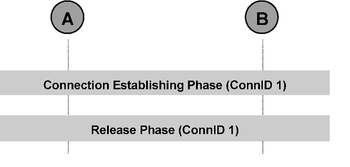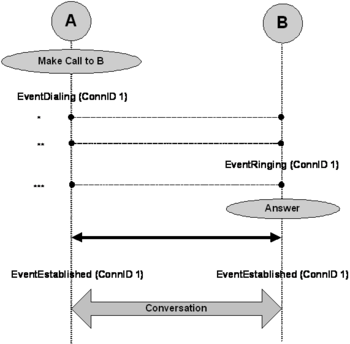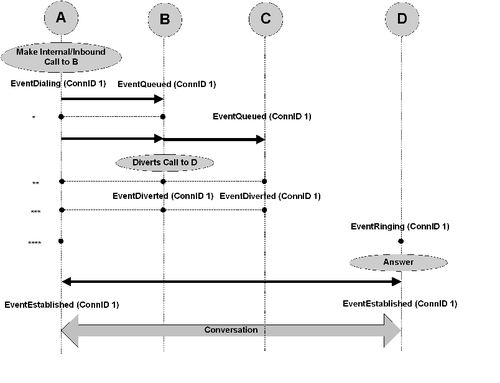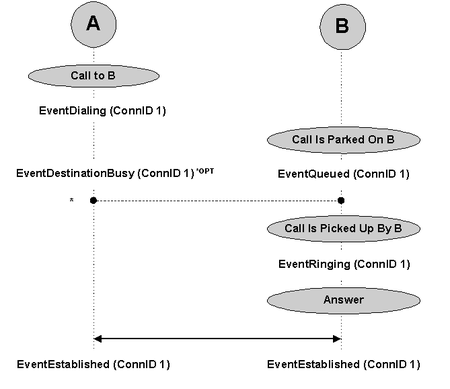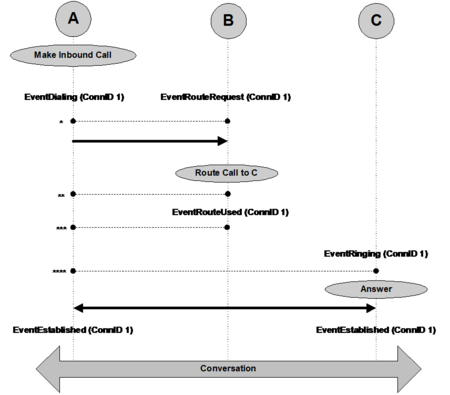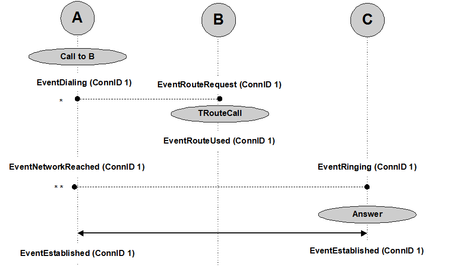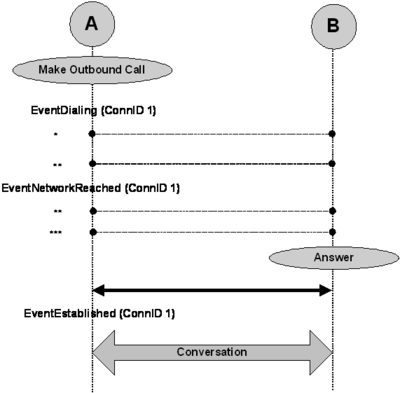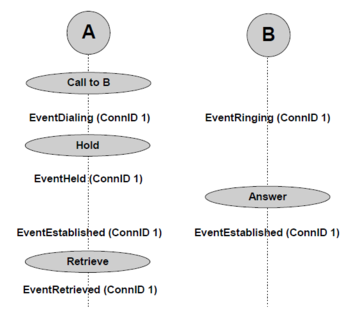Contents
- 1 Basic Call Models
- 1.1 Simple Call Model
- 1.2 Connection-Establishing Phase (Internal/Inbound Call)
- 1.3 Connection-Establishing Phase (Internal/Inbound Call to ACD)
- 1.4 Connection-Establishing Phase (Internal/Inbound Call Queued to Multiple ACDs)
- 1.5 Connection-Establishing Phase (Internal/Inbound Call with Call Parking)
- 1.6 Connection-Establishing Phase (Internal/Inbound Call with Routing—RouteQueue Case)
- 1.7 Connection-Establishing Phase (Internal/Inbound Call with Routing)
- 1.8 Connection-Establishing Phase (Internal/Inbound Call with Routing Outbound)
- 1.9 Connection-Establishing Phase (Outbound Call)
- 1.10 Connection-Establishing Phase While On Hold (Internal/Outbound Call)
Basic Call Models
This section documents the basic scenarios under which calls arrive in a contact center.
Note the following comments in the call models:
*OPT—Optional.
*DIAL—May be a dialed number or is not present if T-Server has no information about the other party.
Simple Call Model
Connection-Establishing Phase (Internal/Inbound Call)
The following graphic and table describe the connection establishing phase (internal/inbound call).
| PARTY A | PARTY B |
|---|---|
| Make Call to B (TMakeCall) | |
| EventDialing ConnID 1 |
|
| EventRinging ConnID 1 | |
| Answer (TAnswerCall) | |
| EventEstablished ConnID 1 |
EventEstablished ConnID 1 |
|
Conversation | |
| Interruption Point | PARTY A | PARTY B |
|---|---|---|
| * | EventReleased ConnID 1 |
|
| ** | EventDestinationBusy ConnID 1 |
|
| *** | EventReleased ConnID 1 |
EventAbandoned ConnID 1 |
a. CallState may have values that clarify the reason for the destination being busy, for instance CallState SitInvalidNum.
Connection-Establishing Phase (Internal/Inbound Call to ACD)
The following graphic and table describe the connection establishing phase (internal/inbound call to ACD).
| PARTY A | PARTY B (ACD Group) | PARTY C |
|---|---|---|
| Make Call to B | ||
| EventDialing ConnID 1 |
EventQueued ConnID 1 |
|
| Diverts call to C | ||
| EventDiverted ConnID 1 |
||
| EventRinging ConnID 1 | ||
| Answer (TAnswerCall) | ||
| EventEstablished ConnID 1 |
EventEstablished ConnID 1 | |
|
Conversation | ||
| Interruption Point | PARTY A | PARTY B | PARTY C |
|---|---|---|---|
| * | EventReleased ConnID 1 |
EventAbandoned ConnID 1 |
|
| ** | EventReleased ConnID 1 |
||
| *** | EventReleased ConnID 1 |
EventAbandoned ConnID 1 |
Connection-Establishing Phase (Internal/Inbound Call Queued to Multiple ACDs)
The following graphic and table describe the connection establishing phase (internal/inbound call queued to multiple ACDs).
| PARTY A | PARTY B (ACD) | PARTY C (ACD) | PARTY D |
|---|---|---|---|
| Make Internal/Inbound Call to B (ACD) | |||
| EventDialing ConnID 1 |
EventQueued ConnID 1 |
||
| EventQueued ConnID 1 |
|||
| Diverts Call to D | |||
| EventDiverted ConnID 1 |
EventDiverted ConnID 1 |
||
| EventRinging ConnID 1 | |||
| Answer (TAnswerCall) | |||
| EventEstablished ConnID 1 |
EventEstablished ConnID 1 | ||
|
Conversation | |||
a. For ACD configurations where calls are distributed to agents assigned directly to ACD groups, CallState and its value of Redirected are present. For ACD configurations where calls are distributed to agents assigned to secondary ACD groups associated with top-level ACD queues, the CallState, with the value Redirected, is not present.
| Interruption Point | PARTY A | PARTY B | PARTY C | PARTY D |
|---|---|---|---|---|
| * | EventReleased ConnID 1 |
EventAbandoned ConnID 1 |
||
| ** | EventReleased ConnID 1 |
EventAbandoned ConnID 1 |
EventAbandoned ConnID 1 |
|
| *** | EventReleased ConnID 1 |
|||
| **** | EventReleased ConnID 1 |
EventAbandoned ConnID 1 |
Connection-Establishing Phase (Internal/Inbound Call with Call Parking)
The following graphic and table describe the connection establishing phase (internal/inbound call with call parking).
| PARTY A | PARTY B |
|---|---|
| Make Call To B (TMakeCall) | |
| EventDialing ConnID 1 |
|
| Call Is Parked On B | |
| EventDestinationBusy *OPT ConnID 1 |
EventQueued ConnID 1 |
| Call Is Picked Up By B | |
| EventRinging ConnID 1 | |
| Answer (TAnswerCall) | |
| EventEstablished ConnID 1 |
EventEstablished ConnID 1 |
|
Conversation | |
| Interruption Point | PARTY A | PARTY B |
|---|---|---|
| * | EventReleased ConnID 1 |
EventAbandoned ConnID 1 |
Connection-Establishing Phase (Internal/Inbound Call with Routing—RouteQueue Case)
The following graphic and table describe the connection establishing phase (internal/inbound call with routing - RouteQueue case).
| PARTY A | PARTY B (Routing Point/CDN) | PARTY C |
|---|---|---|
| Make Incoming Call to Information Service | ||
| EventDialing ConnID 1 |
EventQueued ConnID 1 |
|
| Route Call to C a (TRouteCall) | ||
| EventRouteUsed ConnID 1 |
||
| EventRinging ConnID 1 | ||
| Answer (TAnswerCall) | ||
| EventEstablished ConnID 1 |
EventEstablished ConnID 1 | |
|
Conversation | ||
a. RouteCall to C (TRouteCall()) may be missing.
| Interruption Point | PARTY A | PARTY B | PARTY C |
|---|---|---|---|
| * And |
EventReleased ConnID 1 |
EventAbandoned ConnID 1 |
|
| *** | EventReleased ConnID 1 |
||
| **** | EventReleased ConnID 1 |
EventAbandoned ConnID 1 |
a. RouteCall to C (TRouteCall()) may be missing.
Connection-Establishing Phase (Internal/Inbound Call with Routing)
The following graphic and table describe the connection establishing phase (internal/inbound call with routing).
| PARTY A | PARTY B (Routing Point/CDN) | PARTY C |
|---|---|---|
| Make Incoming Call to Information Service | ||
| EventDialing ConnID 1 |
EventRouteRequest ConnID 1 |
|
| Route Call to C a (TRouteCall) | ||
| EventRouteUsed ConnID 1 |
||
| EventRinging ConnID 1 | ||
| Answer (TAnswerCall) | ||
| EventEstablished ConnID 1 |
EventEstablished ConnID 1 | |
|
Conversation | ||
a. Not present if a call has been routed by default; that is, a switch did not receive any routing instruction from a computer domain within a timeout configured on the switch side (scripted or otherwise) and therefore processed the call using switch logic. b. Content of ThirdPartyDN depends on the call scenario:
- If information about the destination is available at the moment EventRouteUsed is generated, this attribute is mandatory; a DN where the call has been delivered must be reported.
- If the information is not available, but the call has been routed through T-Server, this attribute is mandatory; a DN where the call has been sent must be reported.
- If a call has been routed to a default destination or routed by another application, this attribute is optional (depends on switch capabilities).
c. CallState has a value of Redirected (22) if a call has been routed by a switch. For Aspect ACD, Rockwell Spectrum, and Hicom 300 E CS switches, the attribute Callstate is not present.
| Interruption Point | PARTY A | PARTY B | PARTY C |
|---|---|---|---|
| * | EventReleased ConnID 1 |
EventAbandoned ConnID 1 |
|
| ** | EventReleased ConnID 1 |
EventAbandoned a ConnID 1 |
|
| *** | EventReleased ConnID 1 |
||
| **** | EventReleased ConnID 1 |
EventAbandoned ConnID 1 |
a. EventError must be sent after EventAbandoned in this case to make the ReferenceID available.
Connection-Establishing Phase (Internal/Inbound Call with Routing Outbound)
The following graphic and table describe the connection establishing phase (internal/inbound call with routing outbound).
| PARTY A | PARTY B (Routing Point) | PARTY C |
|---|---|---|
| Incoming Call | ||
| EventDialing ConnID 1 |
EventRouteRequest ConnID 1 |
|
| Route Call to C a (TRouteCall) | ||
|
EventRouteUsed ConnID 1 |
|
| Answer (TAnswerCall) | ||
| EventEstablished ConnID 1 |
EventEstablished ConnID 1 | |
|
Conversation | ||
a. Not present if a call has been routed by default; that is, a switch did not receive any routing instruction from a computer domain within a timeout configured on the switch side (scripted or otherwise) and therefore processed the call using switch logic. b. Content of ThirdPartyDN depends on the call scenario:
- If information about the destination is available at the moment EventRouteUsed is generated, this attribute is mandatory; a DN where the call has been delivered must be reported.
- If the information is not available, but the call has been routed through T-Server, this attribute is mandatory; a DN where the call has been sent must be reported.
- If a call has been routed to a default destination or routed by another application, this attribute is optional (depends on switch capabilities).
c. CallState has a value of Redirected (22) if a call has been routed by a switch. For Nortel Communication Server 1000 with SCCS MLS, Aspect ACD, Rockwell Spectrum, and Hicom 300 E CS switches, the attribute CallState is not present.
| Interruption Point | PARTY A | PARTY B | PARTY C |
|---|---|---|---|
| * | EventReleased ConnID 1 |
EventAbandoned ConnID 1 |
|
| ** | EventReleased ConnID 1 |
EventAbandoned ConnID 1 |
Connection-Establishing Phase (Outbound Call)
The following graphic and table describe the connection establishing phase (outbound call).
| PARTY A | PARTY B |
|---|---|
| Make Outside Call (TMakeCall) | |
| EventDialing ConnID 1 |
|
| EventNetworkReached a ConnID 1 |
|
| Answer | |
| EventEstablished ConnID 1 |
|
|
Conversation | |
a. When a switch does not report network reached, T-Server simulates EventNetworkReached right before distributing EventEstablished.
| Interruption Point | PARTY A |
|---|---|
| * | EventReleased ConnID 1 |
| ** | EventDestinationBusy ConnID 1 |
| *** | EventReleased ConnID 1 |
a. CallState may have values that clarify the reason for the destination being busy, for instance CallStateSitInvalidNum.
Connection-Establishing Phase While On Hold (Internal/Outbound Call)
The following graphic and table describe the connection establishing phase (internal/outbound call).
| PARTY A | PARTY B |
|---|---|
| Call to B | |
| EventDialing ConnID 1 |
EventRinging ConnID 1 |
| Hold | |
| EventHeld ConnID 1 |
|
| Answer | |
| EventEstablished ConnID 1 |
EventEstablished ConnID 1 |
| Retrieve | |
| EventRetrieved ConnID 1 |

